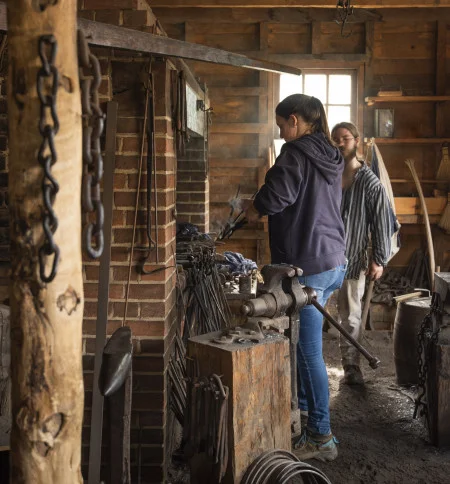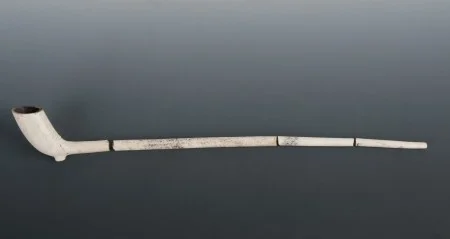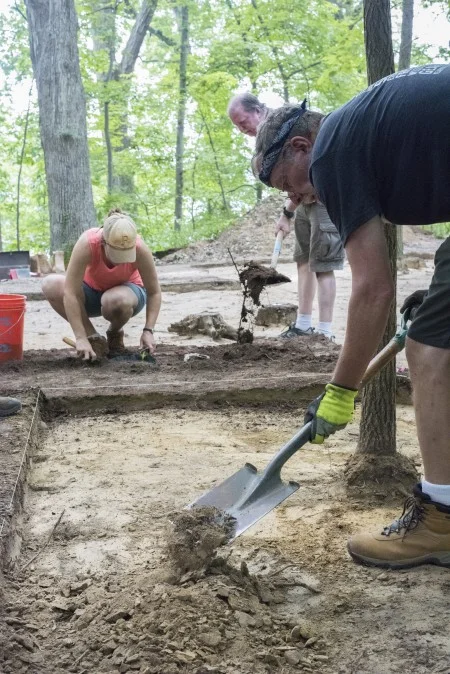Preservationists use a wide range of terminology in their work. Explore this list of some of their most commonly used terms and tools.
Colonoware
A low-fired, locally-made coarse earthenware associated with native and enslaved populations in the American colonies of the 17th through to the 19th century. Found on many domestic archaeological sites in the southeastern US and the Caribbean, colonoware made by Native Americans and African Americans in forms that drew inspiration from Indian, African, and English utilitarian designs. The extensive colonoware assemblage excavated from the South Grove Midden tells us of the cultural complexity of 18th century Virginia as enslaved populations interacted with native peoples while inhabiting a world recently saturated by European cultures.
Compound Tool
A tool made of two or more different materials. This possible toothbrush found in the South Grove Midden is made of delicately carved animal bone. Copper alloy wires still visible on the back would have held horsehair tail bristles in place.
Conservation
Conservation is action that halts deterioration and reverses its effects. Conservation is generally more invasive than stabilization, frequently is executed in situ and involves the treatment of a condition rather than a wholesale replacement of an element.
One simple example is the central passage balustrade; so that we can continue to allow visitors the opportunity to touch a piece of Washington history, each year, our architectural conservator applies a protective coating to the balustrade to prevent damage from wear and tear.
Debitage
The waste by-products, chips or flakes, resulting from the manufacture of stone tools. Certain flakes have a unique appearance and indicate the tools that were made or prepared at a site. We have had literal tons of debitage come out of the African American Cemetery which appears to have been a productive tool-making site for prehistoric Native Americans.
Dendritic
Tree-like markings resembling the natural geological markings on moss agate, known as "mocha stone" in Great Britain in the late 18th century. Dendritic decoration, as seen on this chamber pot from Alexandria Archaeology Museum's townhouse well, is a hallmark of mochaware. These motifs were created by dripping an acidic solution onto wet slip resulting in the unique branching appearance. The home brewed solution could contain a variety of ingredients including tobacco juice, ground iron scale, hops, or even urine.
Documentation
Documentation is essential to effecting a successful preservation program. Documentation is the recording of data about the physical fabric of a historic resource and includes of a number of media: narrative, photography, drawing, digital modeling, and other practices such as paint sampling and dendrochronology. Documenting historic resources provides a baseline for condition assessment, as well as an understanding of the origin and evolution of a resource. It is inseparable from research and restoration.
Geographic Information Systems (GIS)
Computer-generated mapping systems that allow archaeologists to plot and analyze site distributions against environmental and other background data. This map shows grave shafts found archaeologically in Mount Vernon's Slave Cemetry.
Incised
A type of ceramic decoration in which the soft surface of the clay is cut with a sharp instrument. Germanic stoneware such as this Rhenish jug from the South Grove often features a variety of decoration including incised lines that accentuate molded or stamped designs.
Midden
A concentration of deposited refuse and debris associated with human occupation. Discarded material could include broken tools or ceramics, food remains such as animal bones, shells, and seeds, charcoal, architectural cast offs, etc. Since trash is the real treasure to archaeologists, middens are an invaluable source of information. In the 1990's, Mount Vernon archaeologists excavated a massive midden in the South Grove, as pictured. Encapsulating four decades of occupation, over 300,000 artifacts were recovered.
Mitigation
Measures taken to minimize destruction to potential or existing archaeological sites. Many of the archaeological excavations conducted at Mount Vernon are at least partially mitigation driven. For example, the area of the South Grove is cited to be disturbed during the installation of a fire suppression system that will protect the mansion. Before any construction can begin, our archaeologists have been thoroughly documenting every portion of the site for the past 4 years.
Munsell Color Chart
Paint Analysis
Combines a microscopic examination of paint samples and document-based research to determine when successive layers of paint were added to a surface. This paint sample is from the Front Parlor and shows all 15 layers. The reddish-brown (darker) spot at the bottom is the first paint layer and the opaque area below it is plaster. Around the middle are two bluish layers.
Patination
The altered surface and coloring of an artifact made by natural weathering or exposure to soil acids. Glass artifacts, such as these fragmented wine glasses from the House for the Families, often develop an iridescent film as the silica reacts to acidic soil.
Pontil Mark
The characteristic mark left on the base of glass vessels by breaking off the pontil, the glass-blower’s rod. Most glass bottles that exhibit pontil marks or scars can typically be dated to pre-1860 such as this little medicine bottle found during a survey conducted at the gristmill near the distillery.
Preservation
Preservation is the practice of caring for historic structures and landscape features with the goal of understanding them and extending the life of their original fabric indefinitely. In working to attain this goal, the Mount Vernon Architectural Preservation Section follows a straightforward philosophy of prophylactic maintenance and thoughtful repair. Such practice is well established and was eloquently articulated as early as 1839 by the French archaeologist A. N. Didron: “It is better to preserve than to repair, better to repair than to restore, better to restore than reconstruct.”
The goal at Mount Vernon is to preserve as much original fabric as possible through study and documentation and by maintaining structures in good condition, identifying potential and actual problem as early as possible, and effecting the least intrusive and most sympathetic treatments possible. Several practices are key in this process of preservation: research, documentation, preservation maintenance, stabilization, conservation, and restoration.
Preservation Maintenance
Preservation maintenance is the first line of defense in the war against the deterioration of historic resources. It includes all non-invasive activities from daily cleaning and condition assessment to cyclical paint touch-up to providing healthy environmental conditions. On-going preservation maintenance identifies potential and actual problems early, hopefully while they are still minor.
For example, the preservation staff regularly cleans and waxes the period and reproduction locks so that they continue to function effectively without having to be replaced. In addition, the building exteriors are regularly painted in order to seal the envelopes from the weather and pests, preventing undue damage to the exterior and interior. These are just a few examples of the many maintenance activities the preservation team does on a daily basis.
Research
Research is the necessary first step for any preservation work. Research involves the use of archival primary and secondary source data, as well as comparable architectural data. Mount Vernon is blessed with an extraordinary amount of primary source material located in research institutions all over the world. Access to this material has been greatly facilitated through The Papers of George Washington Digital Edition, a searchable compendium of much of the Washington papers. As of May 2014, there remain some papers that have not yet been added to the digital edition.
Restoration
Restoration is the process through which a building, structure or landscape feature is returned to an original, former or unaltered condition. Restoration encompasses projects of all sizes from painting, repairing minor deterioration, or replacement of missing hardware, to large projects such as significant structural repair or the complete return of a resource to its original appearance based on extensive research. Restoration work therefore often encompasses stabilization and conservation activities and spans emergency repairs to large projects that have been provided for under a long-term work plan.
The recently-opened front parlor is an example of a restoration, where stabilization and conservation were executed in order to preserve the 18th-century wood paneling and ultimately return the room to its 18th-century appearance, In order to address cupping (or bowing) in the panels, some were treated with humidification, essentially introducing moisture back into the panels to flatten them, and then removing the moisture, leaving the panels closer to their original, flatter state. In other panels, cracks were treated in place using a fill material.
Schnitt
From the German meaning “a Cut,” the schnitt method involves the earth being taken down in slices to create a level rectangular or square plane. Our archaeologists frequently employ this efficient technique for clearing the top layers of soil at the Slave Cemetery site.
Shovel Test Pit (STP)
A common subsurface detection technique to quickly determine the density and distribution of any archaeological remains. A small section of the area, usually the width and length of a shovel blade, is opened and dug until subsoil is reached. The removed soil is then screened for artifacts. STPs can be used during a preliminary survey of a site or as part of mitigation efforts.
Stabilization
Stabilization is the management of condition and environment in order to minimize the potential negative impact on a resource or one of its component elements and the protection of the resource from further harm.
Examples of stabilization are: the reversal of unfavorable environmental conditions; the installation of temporary or permanent supports in a structure that has experienced rot in its wooden framing members; the application of a chemical in order to arrest deterioration. For example, the majority of the 18th-century rafters in the south garden house still survive; with each new generation of roof, either as an old roof deteriorates or as a new roof is installed, additional stress is put on the rafters. So, a system of sisters (or supporting pieces) was installed to transfer the stress off of the early rafters and ultimately prolong their life. The sisters essentially sandwich the rafters for protection and stability, and they provide an alternate surface to which the shingle nailers can be secured.
Stratigraphy
The study and interpretation of the sequence of deposition of different layers of rocks, sediments, soils, or cultural debris. Stratigraphy is how archaeologists can read a site and establish a relative dating sequence based on the principle that the lowest layer is the oldest and the uppermost is the youngest. Here you can see the distinct layers of backfill from where Bushrod Washington’s dairy once stood in the South Grove.
XRF (X-ray Fluorescence)
An XRF spectrometer works by firing a beam of high energy, short-wavelength radiation at an object. When the x-rays hit the sample, it emits a spectrum of wavelengths characteristic of the types of atoms present. The spectrometer captures and processes this information to generate a detailed profile of an object’s elemental makeup.































